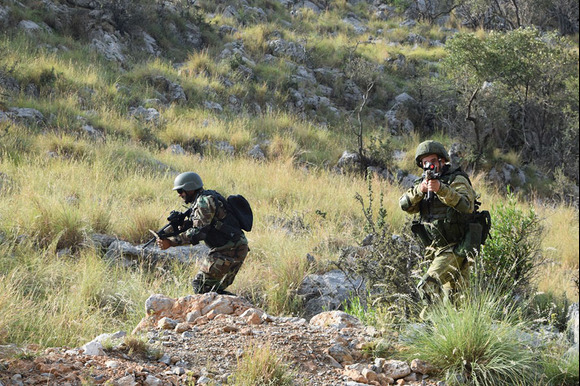
By Mil.ru, CC BY 4.0
Senior military officials from India and Pakistan are scheduled to hold discussions on Monday to work out the detailed framework of the ceasefire agreed upon over the weekend. The meeting comes in the wake of a U.S.-mediated ceasefire between the two nuclear-armed neighbors, which has so far held steady after nearly four consecutive days of intense artillery exchanges and aerial confrontations.
The ceasefire announcement was made by U.S. President Donald Trump on Saturday, who said it was imperative to halt the hostilities to avoid catastrophic loss of life and widespread destruction. “It was time to stop the current aggression that could have led to the death and destruction of so many, and so much,” President Trump said, emphasizing the urgency of de-escalating the situation.
Since the ceasefire took effect, both India and Pakistan have halted their military engagements but remain on high alert. Both sides have issued stern warnings against any violation of the agreement, reinforcing their commitment to retaliate if provoked.
In a significant development, India announced on Monday that it would be reopening 32 airports for civilian use. These airports had previously been closed for safety reasons and were initially expected to remain shut until Thursday. The reopening is seen as a sign of tentative calm returning to the region.
The flare-up last week was the latest chapter in the decades-long conflict between India and Pakistan over the disputed Himalayan territory of Kashmir. Both nations claim Kashmir in its entirety but control different parts of it. The rivalry has already led to two full-scale wars in the past.
The most recent episode of conflict posed a serious risk of escalating into a full-blown war, as neither side appeared ready to de-escalate in the initial days of the fighting. Over the course of four days, both countries engaged in heavy cross-border shelling, resulting in the deaths of dozens of people on both sides, according to official statements.
Despite the ceasefire, both India and Pakistan have each declared military victories in their respective statements following the pause in hostilities.
The escalation began following a militant attack on April 22 in the scenic Pahalgam valley, located in Indian-administered Kashmir. The assault resulted in the deaths of 26 people. India blamed the attack on a Pakistan-based militant organization, a claim Islamabad has categorically denied.
On May 7, in what India described as a retaliatory operation, the Indian military claimed it targeted nine locations inside Pakistan and Pakistan-administered Kashmir. These targets were believed to include armed group training camps. In total, Indian officials said they eliminated over 100 militants through these operations.
In the days that followed, both sides traded accusations of repeated cross-border shelling and claimed aerial victories. India asserted that it had struck 11 Pakistan Air Force bases, including a facility in Rawalpindi near Islamabad. Indian officials also stated that Pakistan suffered between 35 and 40 casualties along the Line of Control, the de facto border separating the two sides. Additionally, India reported the loss of several aircraft during the conflict.
Pakistan acknowledged that some Indian missiles had indeed hit its air force installations, though it did not provide specific details. Meanwhile, the Pakistan military claimed it had retaliated by targeting 26 Indian military facilities and that its drones had successfully flown over India’s capital, Delhi. While Indian authorities confirmed that Pakistani projectiles had struck some of their air bases, they have not publicly addressed the claim of drone incursions over the capital.
Further adding to the claims and counterclaims, Pakistan announced that it had shot down five Indian aircraft, including three French-made Rafales. India has not verified or denied the specific numbers but did release a statement on Sunday saying, “losses are a part of combat,” without providing further elaboration.
Another contentious issue arose when Pakistan initially claimed that an Indian pilot had been captured after ejecting from a downed aircraft. However, Pakistan later denied that any Indian pilot was in its custody. India, on its part, affirmed that “all our pilots are back home,” effectively dismissing the claims of any capture.
As both nations gear up for further talks, the international community watches closely, hoping the fragile ceasefire can evolve into a longer-term resolution of the long-standing conflict.




